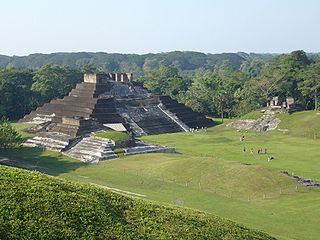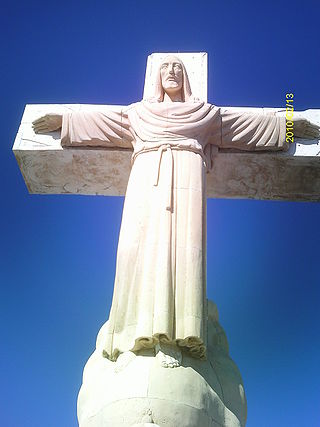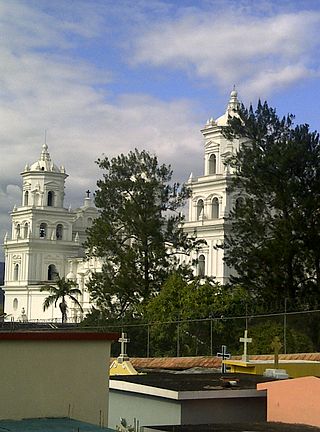Tabasco | |
|---|---|
 | |
| Coordinates: 21°52′N102°55′W / 21.867°N 102.917°W | |
| Country | Mexico |
| State | Zacatecas |
| Municipality | Tabasco |
| Founded | 1543–50 |
Tabasco is a small town in the state of Zacatecas, Mexico.
Tabasco | |
|---|---|
 | |
| Coordinates: 21°52′N102°55′W / 21.867°N 102.917°W | |
| Country | Mexico |
| State | Zacatecas |
| Municipality | Tabasco |
| Founded | 1543–50 |
Tabasco is a small town in the state of Zacatecas, Mexico.
The town of Tabasco is the municipal seat of Tabasco Municipality.
On 9 April 2023, a 31 m (102 ft) tall statue of Jesus Christ was inaugurated atop the Cerrito de la Fe in Tabasco Municipality. [1] The monument, officially titled El Cristo de la Paz (The Christ of Peace), is the tallest sculpture of Jesus Christ in Latin America, being a meter taller than the Cristo Redentor (not including pedestal). [1]

Tabasco, officially the Free and Sovereign State of Tabasco, is one of the 32 Federal Entities of the United Mexican States. It is divided into 17 municipalities and its capital city is Villahermosa.

Torreón is a city and seat of Torreón Municipality in the Mexican state of Coahuila. As of 2021, the city's population was 735,340. The metropolitan population as of 2015 was 1,497,734, making it the ninth-biggest metropolitan area in the country and the largest metropolitan area in the state of Coahuila, as well as one of Mexico's most important economic and industrial centers. The cities of Torreón; Gómez Palacio, Durango; Lerdo, Durango; Matamoros; Francisco I. Madero; San Pedro; Bermejillo, Durango; and Tlahualilo, Durango form the area of La Laguna or the Comarca Lagunera, a basin within the Chihuahuan Desert.

The Apostolic Assembly of the Faith in Christ Jesus (AAFCJ) is a Oneness Pentecostal denomination in the United States. It was founded in 1925 and incorporated in California on March 15, 1930, and is currently headquartered in Fontana, California.

Christ the Redeemer is an Art Deco statue of Jesus Christ in Rio de Janeiro, Brazil, created by French-Polish sculptor Paul Landowski and built by Brazilian engineer Heitor da Silva Costa, in collaboration with French engineer Albert Caquot. Romanian sculptor Gheorghe Leonida sculpted the face. Constructed between 1922 and 1931, the statue is 30 metres (98 ft) high, excluding its 8-metre (26 ft) pedestal. The arms stretch 28 metres (92 ft) wide. It is made of reinforced concrete and soapstone. Christ The Redeemer differs considerably from its original design, as the initial plan was a large Christ with a globe in one hand and a cross in the other. Although the project organizers originally accepted the design, it later changed to the statue of today, with the arms spread out wide.

Otatitlán is a town and municipality in the Mexican state of Veracruz, in the south of the state along the border with the state of Oaxaca. The town is best known for its large black image of a crucified Christ, one of three notable images of this type. Most of the population in Otatitlán is poor and the area is dedicated to agriculture, especially sugar cane and bananas.

Zacatecas is a state in North Central Mexico that is divided into 58 municipalities. According to the 2020 Mexican census, it is the state that has the 7th smallest population with 1,622,138 inhabitants and the 8th largest by land area spanning 75,275.3 square kilometres (29,064.0 sq mi).

Urbici Soler (1890–1953) was an American sculptor and art educator. He is remembered chiefly for Cristo Rey, a monumental statue of Jesus on the cross atop Mount Cristo Rey in the El Paso suburb of Sunland Park, New Mexico, which he completed in 1939 and which is a site of Roman Catholic pilgrimage.

Cristo Rey is a statue on top of Cerro del Cubilete,, a 200 metres (660 ft) mountain in Silao Municipality in Guanajuato, Mexico.

The Sanctuary of Christ the King is a Catholic monument and shrine dedicated to the Sacred Heart of Jesus Christ overlooking the city of Lisbon situated in Almada, in Portugal. It was inspired by the Christ the Redeemer statue of Rio de Janeiro, in Brazil, after the Cardinal Patriarch of Lisbon visited that monument. The project was inaugurated on 17 May 1959. The giant statue was erected to express gratitude because the Portuguese were spared the direct destructive effects of World War II.
Events in the year 1914 in Mexico.

Cristo de la Concordia is a statue of Jesus Christ located atop San Pedro Hill, to the east of Cochabamba, Bolivia. It is accessible by cable car, or by climbing 2,000 steps. The statue is 33.44 metres (109.7 ft) tall, on a pedestal of 6.24 metres (20.5 ft), for a total height of 39.68 metres (130.2 ft).

The Cristos Negros or Black Christs of Central America and Mexico trace their origins to the veneration of an image of Christ on a cross located in the Guatemalan town of Esquipulas, near the Honduran and Salvadoran border. This image was sculpted in 1595 in wood and over time it blackened and gained a reputation for being miraculous. Little is known of how veneration of the image was spread by clergy, although there are records of its introduction in various locations, especially in Central America, southern Mexico, central Mexico and even as far north as New Mexico. However, a number of these images, such as the ones in Chalma, State of Mexico and Mérida, Yucatán have origin stories that do not connect the local image with that of Esquipulas. The Cristo Negro of Esquipulas remains an important symbol for Central America, with its sanctuary the most visited site in the region. On January 11, 2021, a replica of Christ of Esquipulas and his accompanying statues were donated to Saint Joseph Cathedral of Antigua Guatemala eliciting an uncontainable and renewed veneration for Black Christ of Esquipulas among his followers. There are hundreds of other such images with at least local importance with Christ of Chalma attracting millions of visitors, second only to that of the Virgin of Guadalupe in Mexico. The popularity of the image continues to spread, with Central American and Mexican migrants bringing the image to the United States and Canada, founding new sanctuaries.
Events in the year 1993 in Mexico.
The Liga de Expansión MX, officially known as Liga BBVA Expansión MX for sponsorship reasons, is a Mexican football league founded in 2020 as part of the Mexican Football Federation's "Stabilization Project", which has the primary objective of rescuing the financially troubled teams from the Ascenso MX and prevent the disappearance of a second-tier league in Mexico. The project also attempts for Liga MX and former Ascenso MX teams to consolidate stable projects with strong administration, finances, and infrastructure.
The 2020–21 Liga de Expansión MX season is the first professional season of the second-tier football division in Mexico. The season is divided into two championships—the Torneo Apertura and the Torneo Clausura—each in an identical format and each contested by the same sixteen teams. The Apertura tournament started on 18 August 2020 and concluded on 20 December 2020. The Clausura tournament started on 12 January 2021 and will conclude in May 2021.

Santa María de la Paz is a municipality in the Mexican state of Zacatecas, located approximately 165 kilometres (103 mi) southwest of the state capital of Zacatecas City.
The 2022–23 Liga de Expansión MX season was the third professional season of the second-tier football division in Mexico. The season is divided into two championships—the Torneo Apertura and the Torneo Clausura—each in an identical format and each contested by the same eighteen teams. The Apertura tournament began on 24 June 2022. The Clausura tournament will began in January 2023.